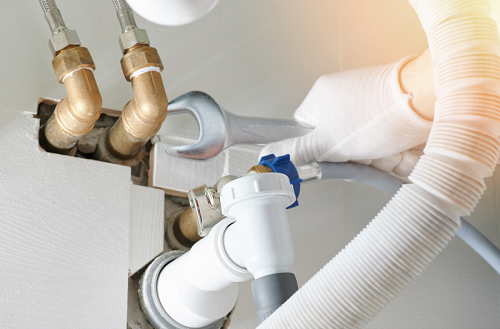The drain is the underground pipe that carries the wastewater out of your home and into the main plumbing system. In most cases, the toilet and the sink have separate drain lines that ultimately attach to a single line leading to the sewer. However, running individual drains for each of these bathroom fixtures seems inefficient and expensive. Having the same drain for your toilet and sink would make more sense. But wait, can a toilet and sink share the same drain? Let’s find out.
How Your Home’s Drainage System Works
Before we answer this question, let’s walk you through how a residential drainage system in the US works. The drainage system relies on gravity to pull waste and dirty water from your home to the sewer system.
All plumbing fixtures in your home, including the toilet and sink, have separate drainpipes, but they ultimately empty their contents to the main sewer line. To answer your question, yes, a toilet and a sink can share the same drain.
As a matter of fact, most of the plumbing fixtures in your bathroom can share the same drain. You can have the same drain from your toilet and shower, toilet and kitchen sink, bath and sink, and so forth.
How the Toilet and Sink Use the Same Drain
If you live in the US, it’s highly likely that the water that runs in your kitchen, toilet, sink, and shower comes from the same source. Similarly, the mixture of domestic wastewater from all plumbing fixtures in your home drains at the same place.
Instead of having separate drainpipes, various plumbing fixtures in your home, such as the toilet and sink can use the same drain. A plumber can attach the toilet drain line and sink drain in the floor beneath the bathroom, combining them into one.
The Benefits of Having the Same Drain for The Toilet and Sink
As a homeowner, you should never jump into any remodeling project without some due diligence. Before you go ahead and combine the toilet drain and sink drain in your home, it’s imperative that you explore why it may be a good idea.
Here are the main benefits of having the same drain for your toilet and sink.
1. More Practical
Using the same drain for your toilet and sink is more practical than having separate drains for the toilet and the sink. It just makes more sense since the drains from all plumbing fixtures in your home end up in the same place.
2. Easier Installation
Having the same drain for the toilet and sink reduces installation time. Separate drainpipes mean you have to map out how every pipe will fit into the structure of your home without getting in the way of each other, which means more work in the planning and execution stages.
3. Less Expensive
Laying down separate drains for each plumbing fixture is more expensive. As mentioned above, it increases planning and installation time, leading to higher labor costs. Additionally, you need more parts for the job, which means more money.
Potential Issues with Connecting the Toilet Drain and Sink Drain
Clearly, using the same drain for the toilet and sink is the more practical, affordable, and less time-consuming option when it comes to your home’s drainage system. However, some issues may arise, especially if the drains are not connected properly.
A potential issue with combining the sink and the toilet drain is the airlock. An airlock forms when pockets of air are trapped by the flowing water, impeding the free flow of water. One way to prevent air lock is by installing a common valve between the drains (more on this later in the article).
How To Connect the Toilet and Sink Drain
Having established that the toilet and sink can share a drain, we’ve also learned that using the same drain for the toilet and sink has several benefits over having separate drainpipes for each fixture.
Connecting the toilet and sink drain is not overly complicated if you are the handy type or have some plumbing experience. Start by joining the toilet and sink drainpipes two-to-three-inch PVC sweeping-Y connector. Make sure that the sink drain enters the toilet drain from above.
Cut out a section of the three-inch drainpipe to tie in the two-inch sink drain, then apply prep liquid and PVC glue to secure the connection. Flush the toilet to see if there are leakages or any other issues before proceeding to cover the drain pipe and wrap up the installation.
Tips To Connect the Toilet and Sink Drain Safely
The key to safely combining the toilet and sink is to install the drains properly. You can always hire a plumber for this project to avoid making a mess. But if you feel you’re up to the task, here are a few things to remember.
1. The Sink Drain Empties into the Toilet Drain
One of the most important things to remember is that the sink drain empties into the toilet drain, not the other way around. The toilet drain is the larger of the two drainpipes, so it’s not practical for it to empty into the sink drain.
2. The Toilet Drain Should Be Large Enough to Handle the Combined Flow
Naturally, the toilet drain should be considerably larger than the sink drain, but it may not be large enough in your case. It should be large enough to accommodate the combined flow of both drains. Make sure the toilet drain is at least three inches in diameter.
3. Install a Common Valve to Prevent Air Lock
As mentioned previously in the article, airlock is a potential issue when it comes to connecting the toilet drain and sink drain. Plumbers avoid this problem by installing a common valve within a 1.5m radius from both drains. The valve allows wastewater to drain freely without an airlock.
Airlock is a serious plumbing issue that you want to avoid at all costs. An airlock constricts the flow of water inside your pipes, leading to sewage backups in your bathroom and potential pipe damage. A common valve is the only way your toilet and sink can safely share the same drain.
FAQs
Is the Toilet Drain Connected to the Sink Drain
As mentioned above, every plumbing fixture in your home, including the sink and toilet, have separate drains that transport water and other contents to the main sewer. That means every toilet, sink, shower, and anything else that utilizes water in your home connects to one particular pipe.
Does Kitchen Sink Drain to Sewer Line
Although your home’s kitchen sink, bathtub, shower, and other fixtures have separate drain lines, they all ultimately connect to one line that deposits everything into the sewer.
Can A Toilet and Shower Share the Same Drain?
Just like the toilet and the sink, a toilet and shower can share the same drain. The key is to ensure that the drains are correctly connected. A proper connection must include a common vent to prevent airlock, ensuring free flow of water between the drains with no backflow.
You can combine the drainpipes from any plumbing fixtures in your home, not just the toilet and sink. Even two toilets can share the same drain, so keep that in mind if you have more than one toilet in your home.
The drains from plumbing fixtures in your home, including the toilet and sink, eventually end up in the same place. Having separate drainpipes makes little sense from a cost and practicality standpoint. Luckily, homeowners can combine drains so that the toilet and sink share the same drain.



